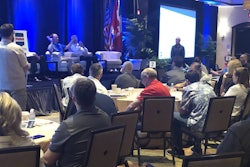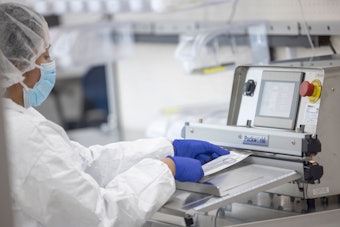Robots are more versatile than ever, and, as a result, the applications they address are expanding beyond the common palletizing and case packing operations into the handling of food. Once banned due to major sanitation and hygienic design barriers that prevented OEMs from implementing them into equipment lines, new versions of high protection class robots with wash down capabilities are becoming more prevalent in food processing environments for cutting, slicing, placing and portioning, for example. While there are still space, speed and safety limitations—as well as the robots’ inability to make decisions (which humans can provide)—when end-users can’t find the manpower to operate equipment, robots have helped OEMs win the order.
According to PMMI’s 2018 Industrial Robot Opportunities in Food and Beverage Processing report, the industrial robot market in North and South America was estimated to be $3.5 billion in 2017, with the U.S. accounting for more than 70 percent of those sales. While the automotive industry still accounts for the largest portion of the market—at 34.2 percent, the food and beverage and personal care segments captured 13 percent of all industrial robots sold in the Americas.
And what are food and beverage and CPG companies looking for from a robot? Speed, flexibility, reliability and ease of use. Collaborative systems are also high on the list, as are add-on technologies like unique end of arm tooling (EOAT) and artificial intelligence. But first and foremost, the robot must meet Food and Drug Administration (FDA) safety and sanitary requirements.
Hygienic robots are high on a processor’s wish list
Robot deployment in the food and beverage industry has been slower than other sectors due to the strict regulations these manufacturers have to abide by, specifically around direct contact with food. This has limited robot use to palletizing applications. But manufacturers are increasingly developing hygienic robots which is creating new opportunities for the direct and indirect handling of foods.
JLS Automation, an east coast OEM that manufacturers robotic-based equipment for washdown environments, has seen an increase in need and demand for sanitary robotics in the food industry, but also in the packaging industry, as well.
“The desire for a higher sanitary solution and all stainless execution on a robot is pretty strong from the customer base,” says Craig Souser, Chairman and CEO of JLS Automation. “The all stainless execution is a premium and its more expensive, but a lot of customers will still opt for it even if they don’t need it because they know with the hygienic equipment, they could put it anywhere and not have to worry whether or not they are in compliance with sanitary regulations.”
Similarly, in 2018, Virginia-based food processing equipment machine builder F.R. Drake looked for hygienic robots to meet a growing customer demand. But when they discovered a lack of these systems available, the company embarked on developing its own PLC-controlled robot. The F.R. Drake robot design utilizes materials such as stainless steel and titanium that are fully compatible with food processing sanitary standards.
“Robotics allows us to become more versatile in our offerings,” says F.R. Drake president Tom Ivy. “They open up the market to smaller companies because these processors will have one machine loading big sausages and little sausages in different orientations. And when you’re loading products mechanically, you can’t do all that.”
JLS Automation, too, has seen how robotics can address multiple product formats. The company is also experiencing how this form of automation can save the day when it comes to the skills gap its end-user customers are facing.
“Our business has exploded in the past two years,” Souser says. “Part of that is because the equipment is well suited to the applications we are pursuing, but the other part is that the market is very strong because of labor shortages.”
Robots fill vacant jobs
While facing the skills gap themselves, OEMs know first-hand how the workforce shortage dilemma can affect productivity, and they are capitalizing on it. American-Newlong, an Indiana-based OEM that manufacturers bagging equipment, found itself selling its equipment to farmers once it began offering robotic palletizing in a small footprint. These farmers relied on local high school kids to lift and place heavy bags of feed onto a pallet, but as more rural areas became urbanized, the increasing availability of minimum wage jobs led to a shrinking worker pool.
“End users simply cannot find the workforce required to produce the volume of product they need to,” says Wesley Garrett, the pick/pack/palletizing authorized system integrator account manager for FANUC America. “They are always looking for an OEM to create equipment that requires minimal operator support.”
According to PMMI’s report, the cost of purchasing an industrial robot compared to the average annual manufacturing wage is divided, with manufacturing wages increasing as the cost of robots decline. The study also indicates that the cost of the robot refers to only the upfront sales price of the robot itself, noting that there are other factors such as integration, software, programming, repairs and electricity consumption that impact the total cost of ownership (TCO). Nevertheless, assuming an average 1,783-hour work year, the TCO benefit of introducing robots to replace some human jobs is becoming more advantageous, the study states.
Aside from addressing the shrinking talent pool and skills gap, robots can also relieve human workers from jobs that are dull, dangerous or dirty, allowing those workers to retrain and “upskill” their jobs with more creative and higher value tasks, according to PMMI’s study.
F.R. Drake sells equipment into the Philippines and other areas of the world where food processing plants experience worker shortages daily, and employers have a difficult time finding employees who will show up to work consistently.
“We view labor as being divided into two things: the cost of labor and the availability of labor,” Ivy says. “So, while it only costs a dollar per hour to pay someone to operate equipment in the Philippines, they can’t find anyone. In Australia, it costs $60 an hour to load anything. Robots are appealing to processors in both of these cases for those reasons.”
Collaborative robots (cobots) are also addressing worker safety and the skills gap as they become more popular and appealing to end users.
“Collaborative robots aren’t just for replacing humans on the floor, a lot of times they are used to replace mechanized devices that have a lot more force and speed, which required a build out of equipment around it, and prevent people from working nearby” says Stuart Shepherd, regional sales director at Universal Robots, a manufacturer of collaborative robotic arms.
Cobot adoption continues even as questions arise
Over the past five years, collaborative robots have joined the industrial robot portfolio. Cobots are equipped with additional sensing, which allows it to quickly identify foreign objects within its working envelope and stop movement immediately, preventing worker injury. Because they can operate without a working cell, fencing or light curtains, the footprint of the robot is minimized, and the cost of ancillary equipment is reduced.
“With traditional robots, the capital costs for the robots themselves account for only 25 to 30 percent of the total system costs,” Shepherd says. “The remaining costs are associated with robot programming, setup, and dedicated, shielded work cells. The out of box experience with a collaborative robot is typically less than an hour. That’s the time it takes to unpack the robot, mount it and program the first simple task.”
While a cobot’s claim to fame is that it can work safely alongside humans without additional caging equipment, OEMs and end users have learned that may not be the case for all applications.
“End users and machine builders want to see free range robots without fences,” says Dean Elkins, segment leader of material handling at Yaskawa Motoman. “And my response to that is, ‘please show me your risk assessment.’”
Because there are still safety hazards and risks associated with collaborative robots, Elkins says Yaskawa Motoman has tried to develop an inherently safer collaborative robot with more thorough sensing technology. Its robots use 12 sensors—two per degree of freedom—which allows the robot to sense opposing forces more immediately.
But still, depending on the application and the end tools used on the arm of the robot, collaborative robots can be just as dangerous as other high-speed industrial robots.
“Everyone says collaborative robots are ‘safe’ and that they can save a lot of space and money because they don’t have to put cages up guarding around them,” says Rick Brookshire, group product manager at Epson Robotics. “The story sounds great, but the reality is the majority of end users have to put guarding up anyway because after you add the tooling to them, the total robot systems are no longer safe. Collaborative robots are slower by nature, so if you are going to have to add guarding, put a cage up anyway. You’re better off going with an industrial robot which provides more speed and precision.”
Universal Robots’ Stuart Shepherd agrees that a risk assessment is imperative but adds that the vast majority of UR cobots deployed operate with no safety guarding. “If your cobot is equipped with a torch or another potentially dangerous end-effector, you obviously need to guard it,” he says. “But if you have a cell where you want the cobot to operate faster than what a risk assessment allows, there are several additional safety precautions you can add; a safety zone triggered by an area scanner that makes the robot slow down once a person enters the work envelope is a popular solution.”
Because collaborative robots are frequently advertised as safe robots that can work alongside humans, a lot of end users without prior robot experience may have unrealistic expectations of the capabilities of a cobot, according to Omron’s robotics engineering supervisor Mark Noschang. But like with any other new technology, it’s critical for end users to be educated on how to properly operate and get the most out of their equipment. And it’s on the machine builder to let them in on the specs, Noschang says.
“There have been companies who have adopted cobots because they want a robot that can work side by side with individuals,” Noschang says. “But they don’t realize that the system has to be qualified as safe by qualified safety personnel. The robot itself is neither safe or unsafe, but it comes down to the application that deems it safe or not.”
To help support its machine builder partners in educating their end-user customers on robot safety, Omron has a group that is devoted to evaluating the safety of robotic cells and making recommendations for cells that aren’t in compliance with safety guidelines.
Another common hesitation heard among machine builders is that cobots can’t handle high-speeds. While partly true, each cobot is different, and can certainly be customized during the programming process.
“Our robots can be used as a hybrid,” Elkins says. “Builders can mingle both the power force limiting features of the cobot when it’s moving slower and the faster motion aspects of industrial mode where it’s moving faster, which means you can get a higher aggregate throughput because you aren’t always limited to the slower speeds.”
Because of the advanced sensing technology cobots use to recognize humans in their workspace, the speed can be adjusted to accommodate a higher throughout when workers aren’t around, and then slow down as they re-enter the cobot’s workspace.
Programming such an intuitive reaction may appear to be yet another hurdle of robot adoption, but the days of programming are quickly becoming a thing of the past.
Teachable moments
Many industrial robots are known to require extensive programming to customize the robot to its application. OEMs and end-users alike have struggled to find programmers familiar with robotic languages, which then requires OEMs to implement a comprehensive training program to support the programming and operation of robots. However, significant advancements have been made by robot suppliers to improve the user interface and the ease of programming—which impacts the overall cost.
During PACK EXPO International, Universal Robots put its teach pendant tablet—with its Polyscope software package—in the hands of attendees, which gave them the opportunity to use and operate a UR cobot. The intuitive programming happens directly through the tablet, the user can also “teach” the cobot by physically grabbing the robot arm and move it through the desired trajectory. This approach enables people with no prior knowledge in programming to quickly get the cobots up and running, Shepherd says.
“If you can use a cellphone, you can use a robot,” he explains. “During the tradeshow, we had people sit down and program the robot in less than 15 minutes.”
To further speed up cobot integration, the company has also launched the UR Academy, nine online training modules that has more than 30,000 active users from more than 130 countries. “We are the only robot vendor offering robotics training of this caliber free of charge,” says Shepherd. “But we are facing a looming skills gap in the manufacturing industry that we need to bridge by all means possible. Facilitating knowledge creation and access to our cobots is an important step in that direction.”
One of the many aspects of robotic programming has to do with the force in which a robot picks and places objects. The traditional approach to programming a robot’s force is to use mechanical repeatability, but it can be costly, says Samuel Bouchard, CEO of Robotiq, a company that manufactures flexible robot grippers, sensors, vision systems, and programming software for Universal Robots.
“As humans, we use our sense of touch a lot,” Bouchard says. “Without even looking, we grab everyday objects and know exactly where they are and how we should pick them up. I wanted to bring that element of human touch to robot programming.”
And Robotiq’s Force Copilot software does just that by programming the robots to use its sense of touch to adapt accordingly when placing objects into boxes and other forms of packaging.
Epson robotics also created a similar software program for force guidance applications called Force Guide, which helps builders achieve better precision with standard robots than previously possible.
“We have had builders come to us saying they wanted tolerances of 15 micron placement in an assembly of a product,” Brookshire says. “We tie Force Guide into the servo control loop so that we can move using the smallest increments of motion, and by doing that we can feel our way to the placement and orientation required for high precision applications.”
While packaging and processing OEMs may not need to meet tolerances of 15 micron placement, these programs mean reduced programming and more precision.
In another effort to reduce programming time and make it simpler for anyone to effectively commission a robot, Yaskawa Motoman created the Smart Pendant. This teaching pendant has an interactive touchscreen similar to a tablet, which allows users to flow through robot programming in an ergonomic way. Users don’t need to know a high-level programming language as the Smart Pendant speaks in English. The pendant also eliminates the “right hand rule,” which is used to tell the origin of the robot and which direction it can go. One of the device’s patented features called Smart Frame also allows programmers to move the robot with four simple arrows and it automatically calibrates to where the programmer is standing in relation to the robot.
“When dealing with a workforce that may not have industry knowledge or skills, we are all about ease of use, especially when it comes to programming,” Elkins says.
Ease of use translates to vision-guidance, as well, Elkins says, noting that Yaskawa has simplified machine vision in response to machine builders’ demands. Yaskawa offers a simple, easy to use vision interface, along with its Motosight 2D and 3D hardware and software programs. “As emerging industry trends pop up like e-commerce, we have learned that machine builders need to have highly flexible solutions, especially when it comes to vision-guided robotics.”
Similarly, FANUC America recently demonstrated their latest in 2D and 3D vision guidance via iRVision at PACK EXPO International. The integrated iRVision hardware and software is user friendly while allowing for greater process flexibility. The end result is a lower system cost to the end user since products don’t have to be precisely located in expensive fixtures to be picked, according to FANUC’s Garrett.
Singular control speeds time to market
On the opposite end of vision-guided robotics, some OEMs are taking a different approach. Robotic systems use vision to confirm the position of the incoming products, but F.R. Drake is using its own sorting system to convey that information directly into its new sanitary robot, which is using a singular PLC to control the entire system, rather than the robot having its own independent controls.
“Our team has made it so we can just use one PLC for the robot and everything else feeding into it, working in conjunction with the robot versus buying a package robot that’s got its own electronics, and then adding our electronics for feeding that robot,” Ivy says. “The robot can start moving into position because we know where the product is, we don’t have to use a vision system to find it.”
Another demand robotic suppliers have heard from OEMs is the need for a singular controller to accommodate different robot programming languages. Yaskawa’s answer is its MLX300, a singular control type of programming screen that allows users that may be more conversant in PLC language, rather than robot language, to program Yaskawa robots in the language that they know.
“We are more language agnostic in that way,” Elkins says. “We also have been a long proponent of singular control to program any number of devices for our robots using the same software, codes and function blocks. In the OEM world, that simplifies programming. You can have all of the upstream devices programmed in the same environment with the same processor that you are programming the robot with. At the end of the day, it speeds your time to market.”
Prepare your workforce
While automation provides new opportunities for machine builders, the potential threat of robots and artificial intelligence eliminating jobs from the current workforce looms over employees. However, with the shrinking talent pool in manufacturing, there aren’t jobs to take, just jobs to fill. According to the Bureau of Labor Statistics, the 2018 manufacturing unemployment rate was just a little more than 3 percent.
According to Jeff Bigger, president of Massman Automation Designs, LLC., Villard-MN., the workforce should be excited about robotics as it will provide workers with more creative opportunities and challenges. However, he also recognizes that robotics make his workforce—regardless of age—wary.
“Robots aren’t here to replace your job, they are here to complement it, and also provide more opportunities for the employees,” Bigger says. “The incoming and current workforce needs to step away from the mindset of being replaced, and step into a mindset where they acknowledge that robots will promote a creative and collaborative space for millennials, and new opportunities for the existing workforce.”






















